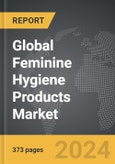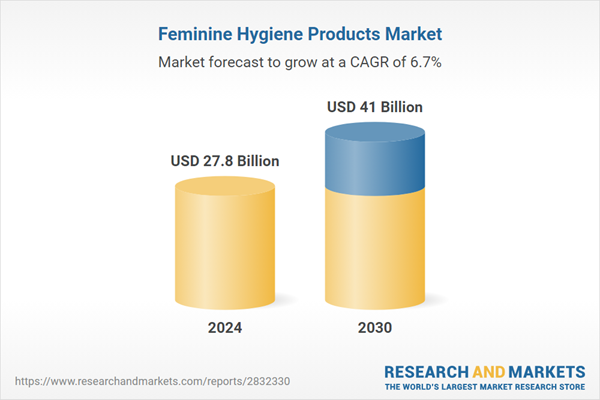The global market for Feminine Hygiene Products was valued at US$27.8 Billion in 2024 and is projected to reach US$41.0 Billion by 2030, growing at a CAGR of 6.7% from 2024 to 2030. This comprehensive report provides an in-depth analysis of market trends, drivers, and forecasts, helping you make informed business decisions.
Global Feminine Hygiene Products Market - Key Trends and Drivers Summarized
Why Are Feminine Hygiene Products Essential for Women's Health and Well-being?
Feminine hygiene products are indispensable for managing menstrual health, providing women with the comfort, protection, and discretion needed during their menstrual cycles. These products include sanitary pads, tampons, menstrual cups, panty liners, and period underwear. Each product type offers unique benefits tailored to various preferences and lifestyles. Sanitary pads and tampons are widely used due to their ease of use and availability, while menstrual cups and period underwear are gaining popularity for their eco-friendliness and cost-effectiveness. Proper menstrual hygiene is crucial for preventing infections and ensuring the overall health and well-being of women. By providing reliable protection, feminine hygiene products enable women to participate fully in daily activities, enhancing their quality of life and confidence.How Has the Women's Liberation Movement Impacted Feminine Hygiene Products?
The Women's Liberation Movement has had a profound impact on the development and perception of feminine hygiene products, transforming them from taboo subjects to essential components of women's health and empowerment. This movement, which gained momentum in the 1960s and 1970s, challenged societal norms and fought for gender equality, including the right to open discussions about menstruation and access to menstrual products. As a result, there has been increased visibility and acceptance of menstrual health issues, leading to innovations and improvements in the design and accessibility of feminine hygiene products. Companies have responded by offering a wider variety of products that cater to different needs and preferences, including organic, reusable, and biodegradable options. The movement has also spurred legislative changes ensuring that menstrual products are provided in public facilities and that they are tax-free in many regions, addressing period poverty and promoting menstrual equity. Overall, the Women's Liberation Movement has been instrumental in making feminine hygiene products more inclusive, accessible, and openly discussed in society.How Are Innovations Transforming the Feminine Hygiene Product Industry?
Innovations in the feminine hygiene product industry are continually enhancing the effectiveness, convenience, and sustainability of these essential items. Technological advancements have led to the development of ultra-thin, highly absorbent materials that offer superior comfort and protection. Additionally, the incorporation of organic and biodegradable materials addresses growing environmental concerns, catering to eco-conscious consumers. Menstrual cups and period underwear, made from medical-grade silicone and sustainable fabrics, represent significant strides towards reducing waste associated with disposable products. Moreover, smart menstrual health products, such as period-tracking apps and wearable devices, are emerging, providing women with valuable insights into their menstrual health and helping them manage their cycles more effectively. These innovations not only improve user experience but also promote a more sustainable approach to menstrual health management.What Challenges and Trends Are Shaping the Feminine Hygiene Product Market?
The feminine hygiene product market is influenced by several challenges and trends. One major challenge is the stigma and lack of education surrounding menstruation, which can hinder access to products and information. Efforts to raise awareness and normalize conversations about menstrual health are crucial for overcoming these barriers. Trends in the market include a growing demand for organic and natural products, driven by increasing awareness of health and environmental impacts. Consumers are seeking products free from harmful chemicals and made from sustainable materials. Additionally, the rise of the 'period poverty' movement highlights the need for affordable and accessible menstrual products for all women, particularly in low-income and marginalized communities. Brands and organizations are responding to these trends by expanding their product lines and launching initiatives to provide menstrual health education and support.What Drives the Growth in the Feminine Hygiene Product Market?
The growth in the feminine hygiene product market is driven by several factors, including increasing awareness of menstrual health and hygiene, rising disposable incomes, and the expanding availability of products. Technological advancements that lead to more effective and sustainable products also contribute to market growth. Additionally, the growing focus on gender equality and women's empowerment promotes the importance of accessible menstrual products. The influence of social media and marketing campaigns that destigmatize menstruation and advocate for better menstrual health management further drive consumer demand. Economic development in emerging markets also plays a significant role, as improved access to education and healthcare leads to higher demand for feminine hygiene products. These factors collectively ensure a dynamic and expanding market, reflecting the evolving needs and preferences of women worldwide.Report Scope
The report analyzes the Feminine Hygiene Products market, presented in terms of market value (US$ Thousand). The analysis covers the key segments and geographic regions outlined below.Segments
Product Type (Sanitary Napkins, Tampons & Menstrual Cups, Panty Liners, Cleaning & Deodorizing Products); Nature (Disposable, Reusable).Geographic Regions/Countries
World; United States; Canada; Japan; China; Europe (France; Germany; Italy; United Kingdom; Spain; Russia; and Rest of Europe); Asia-Pacific (Australia; India; South Korea; and Rest of Asia-Pacific); Latin America (Argentina; Brazil; Mexico; and Rest of Latin America); Middle East (Iran; Israel; Saudi Arabia; United Arab Emirates; and Rest of Middle East); and Africa.Key Insights:
- Market Growth: Understand the significant growth trajectory of the Sanitary Napkins segment, which is expected to reach US$19.4 Billion by 2030 with a CAGR of a 7.3%. The Tampons & Menstrual Cups segment is also set to grow at 5.4% CAGR over the analysis period.
- Regional Analysis: Gain insights into the U.S. market, valued at $7.2 Billion in 2024, and China, forecasted to grow at an impressive 10.1% CAGR to reach $9.9 Billion by 2030. Discover growth trends in other key regions, including Japan, Canada, Germany, and the Asia-Pacific.
Report Features:
- Comprehensive Market Data: Independent analysis of annual sales and market forecasts in US$ Million from 2024 to 2030.
- In-Depth Regional Analysis: Detailed insights into key markets, including the U.S., China, Japan, Canada, Europe, Asia-Pacific, Latin America, Middle East, and Africa.
- Company Profiles: Coverage of major players such as ALBAAD.com, Edgewell Personal Care Company, Johnson & Johnson, Kao Corporation, Kimberly-Clark Corporation and more.
- Complimentary Updates: Receive free report updates for one year to keep you informed of the latest market developments.
Why You Should Buy This Report:
- Detailed Market Analysis: Access a thorough analysis of the Global Feminine Hygiene Products Market, covering all major geographic regions and market segments.
- Competitive Insights: Get an overview of the competitive landscape, including the market presence of major players across different geographies.
- Future Trends and Drivers: Understand the key trends and drivers shaping the future of the Global Feminine Hygiene Products Market.
- Actionable Insights: Benefit from actionable insights that can help you identify new revenue opportunities and make strategic business decisions.
Key Questions Answered:
- How is the Global Feminine Hygiene Products Market expected to evolve by 2030?
- What are the main drivers and restraints affecting the market?
- Which market segments will grow the most over the forecast period?
- How will market shares for different regions and segments change by 2030?
- Who are the leading players in the market, and what are their prospects?
Some of the 242 major companies featured in this Feminine Hygiene Products market report include:
- ALBAAD.com
- Edgewell Personal Care Company
- Johnson & Johnson
- Kao Corporation
- Kimberly-Clark Corporation
- Lil-lets Group Limited
- Natracare Bodywise (UK) Ltd.
- PayChest Inc.
- Playtex Products Inc.
- Procter & Gamble
- Rostam Ltd.
- Svenska Cellulosa Aktiebolaget (SCA)
- THINX Inc.
- Unicharm Corporation
Table of Contents
I. METHODOLOGYII. EXECUTIVE SUMMARY2. FOCUS ON SELECT PLAYERSIII. MARKET ANALYSISSOUTH KOREAREST OF ASIA-PACIFICARGENTINABRAZILMEXICOREST OF LATIN AMERICAIRANISRAELSAUDI ARABIAUNITED ARAB EMIRATESREST OF MIDDLE EASTIV. COMPETITION
1. MARKET OVERVIEW
3. MARKET TRENDS & DRIVERS
4. GLOBAL MARKET PERSPECTIVE
UNITED STATES
CANADA
JAPAN
CHINA
EUROPE
FRANCE
GERMANY
ITALY
UNITED KINGDOM
SPAIN
RUSSIA
REST OF EUROPE
ASIA-PACIFIC
AUSTRALIA
INDIA
LATIN AMERICA
MIDDLE EAST
AFRICA
Companies Mentioned
- ALBAAD.com
- Edgewell Personal Care Company
- Johnson & Johnson
- Kao Corporation
- Kimberly-Clark Corporation
- Lil-lets Group Limited
- Natracare Bodywise (UK) Ltd.
- PayChest Inc.
- Playtex Products Inc.
- Procter & Gamble
- Rostam Ltd.
- Svenska Cellulosa Aktiebolaget (SCA)
- THINX Inc.
- Unicharm Corporation
Table Information
| Report Attribute | Details |
|---|---|
| No. of Pages | 373 |
| Published | February 2025 |
| Forecast Period | 2024 - 2030 |
| Estimated Market Value ( USD | $ 27.8 Billion |
| Forecasted Market Value ( USD | $ 41 Billion |
| Compound Annual Growth Rate | 6.7% |
| Regions Covered | Global |
| No. of Companies Mentioned | 14 |









